Religion
was very important to the ancient Egyptians. They had a different and separate
religion aside from other countries and cultures. Their religion affected their entire daily
life because it was influenced by tradition which caused the Egyptians to
resist change. They did not question the
beliefs and myths that were passed down to them, they also never changed any of
the beliefs. Many of their myths were intended
to explain the gods’ actions and roles in nature.

The
religion of Ancient Egypt was a polytheistic (many gods) with one short period of monotheism (one
god). There were hundreds of different
gods and goddesses. The primary focus
of the Egyptian religion was between the humans and the gods. There was a god for every aspect of the
natural world. Some gods had the heads
of animals that they defied. The Pharaoh
and the priests held a lot of power in Egypt.
The Egyptians believed that when things were going well, the leaders
were doing their job well. But when
things were going bad, the pharaoh and the priests were to blame.
Temples
existed in almost every town, there were temples to serve the spirits of
deceased pharaohs and temples dedicated to the patron gods. Not all gods however, had temples dedicated
to them. The temples were supposed to be
houses for the gods.

The
Egyptians believed in afterlife, they believed that the physical body of the
dead (person) had to be preserved to allow a place for their spirit to live in
the afterlife. This created to process
of mummification to preserve the body.
They preserved bodies of pharaohs then buried them in pyramids (except
King Tut who was buried in the Valley of the Kings). Isis is an ancient
Egyptian goddess that was worshiped as the ideal mother and wife as well as the
matron of nature and magic (the goddess of motherhood, magic and
fertility). Isis had many friends which include slaves, sinners, artisans, the
downtrodden, in addition to listening to the prayers of the wealthy,
maidens, aristocrats and rulers. Isis
was the first goddess of Geb ( god of the Earth). Her name means she of the
throne. Her original headdress was a throne.





